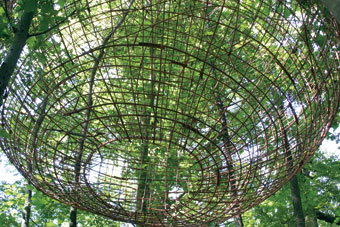Ritschel’s Work
“During the exhibition, viewers meet each other again and again. There is a lot of interaction. They can talk about art and their opinion, and they can build their experiences.”
Ritschel’s practice—as self-defined theory performer and self-taught curator—cultivates an approach to culture that is haptic. “You feel it and make use of it, gaining different perspectives.” As sensory experience joins with academic and practical knowledge through forms of interaction—dialogue, experiment, and motion—artists and viewers stretch into unfamiliar, often uncomfortable, terrain: the domain of change. Understanding and adapting to ever-changing scenarios are the acts that seed creative expression.
Ritschel uses a process she calls “curation” to stage interactive investigative rituals—opening private spaces to broad publics, using public spaces to catalyze personal expression, and activating hidden knowledge by aesthetic means. Her thoroughly creative curatorial practice embraces the intriguing power of the out-of-place.“I like to inscribe places that have not previously had an art association, like buildings and nature,” she says.

Nancy Mladenoff Painted Mushrooms 2002
Ritschel’s earliest independent project, begun in 1995, is “Vogelfrei,” a biennial summer exhibition of art works installed in private gardens throughout Darmstadt. Thousands of city residents visit these otherwise inaccessible gardens to experience innovative and provocative installations over a two week run. According to Ritschel, “The artist occupies a private space expressive of another’s aesthetic, and then transforms it.” Ritschel also likes the way the art works and memories of past projects help visitors see the gardens differently year after year.
In 1998, Ritschel initiated “ARTtafel,” which in 2006 became “K.U.N.S.T. Essen Eins,” in which she collaborates with a chef to create performances involving food. Ritschel fits episodic “Eat-Art” projects in around her curatorial work, positioning herself at center stage to explore such simultaneously obvious and odd themes as “Collagen auf Toast” (collages on toast), “Das Zimtatom” (the cinnamon atom), and “Wissenschaft, Kunst, Pudding” (science, art, pudding).

Edgardo Madanes Blue Glove of the Forest 2006
Building on the success of “Vogelfrei” and seeking ways to activate new audiences, Ritschel began two new curatorial projects in 2002: “KunstTREFFpunkt” and “Internationaler Waldkunstpfad.” These efforts span the urban-rural divide, enlisting participants in exploring new conceptual and geographical territory. Artists become guides, and viewers become producers.
For KunstTREFFpunkt, Ritschel invites one artist or artist team per year to create an ephemeral, interactive, performance-based work on the streets of downtown Darmstadt. During the exhibition, pedestrians encounter an unexpected alteration to their daily routine, an artist-staged disruption that requires their attention and cooperation. Projects ranging from Helina Hukkataival’s solicitation of trash to make a new carpet (Trash Art, 2002) and Marilyn Arsem’s Mary Poppins-esque evening guided tour of mundane minutiae illuminated by her lightbulb-rigged black umbrella (Illumination, 2003) invite Darmstadters to look again at the city they share.

Gail Simpson Harvest 2002
Internationaler Waldkunstpfad is a biennial artist symposium and exhibition set in the Darmstadt Forest. In this project, interdisciplinarity is a key curatorial strategy. Ritschel invites sculptors, performers, printers, installation artists, photographers, and architects of many cultural backgrounds to live together in the forest for three weeks and fabricate works in response to the site and their experience. “I don’t want outdoor furniture. It should be an authentic, direct response to nature—the weather, the landscape, movement, and change.” Ritschel encourages artists to adapt their techniques and materials to the needs of the site. “They need to find their own connection to it.” According to Ritschel, enlisting artists for the exhibition is never difficult. “It is a dream to do something in the German forest,” an evocative place of myth and memory made legendary by the Brothers Grimm and Goethe.
Wisconsin, too, is rich in forest lore. But the pleasant, pastoral journeys narrated by Aldo Leopold and Laura Ingalls Wilder have given way today to stories of evil weevils, bad seeds, and sinister thistles. Drawing upon her experiences working with international artists in urban and natural environments, Ritschel is looking forward to tapping her Arts Institute residency to span the city and the forest, the managed and the wild. She has selected the theme “Native-Invasive” as animating metaphor for her Arts Institute residency, aiming to demonstrate the promise of both local and foreign inspirations for creative acts.
Menu
- Home
- About Ute Ritschel
- Ritschel’s Work
- At UW–Madison
- Symposium